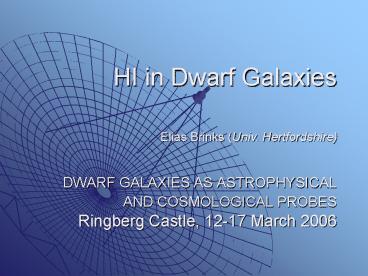HI in Dwarf Galaxies - PowerPoint PPT Presentation
1 / 31
Title: HI in Dwarf Galaxies
1
HI in Dwarf Galaxies
Elias Brinks (Univ. Hertfordshire)
- DWARF GALAXIES AS ASTROPHYSICAL AND COSMOLOGICAL
PROBES Ringberg Castle, 12-17 March 2006
2
Why look at HI?
- The majority of the baryons are in the gas phase
- Vital ingredient for SF (temperature, pressure,
vel. disp., turbulence, etc.) - Tells about on-going and past interactions
- Gives clues about the 3-D shape of dwarfs
- Indispensable in determining Mdyn and hence DM
content and its distribution
3
Questions
- Can we explain the HI structure?
- Evidence for impact of massive SF holes or
artefacts? - HI dispersions why the same in dwarfs and
spirals? - Are our estimates on HI scale heights
correct/reasonable? - The prospects of the SKA
4
Key facts
- HI extends well beyond R25
- Rotation is solid body, often out to Rmax
- dIrr are DM dominated throughout
- DM fraction typically Mdyn ? 10 x Mbaryon
- As MB decreases, MHI M?
- Lower mass limit MHI 5 x 106 - 107 M?
5
Key facts (contd)
- Velocity dispersion 6 - 9 km s-1
- Star Formation occurs above
- N(HI) ? 5 x 1020 cm-2
- dIrr frequently have companions ( 50)
- There are no Dark Galaxies
6
NGC6822
de Blok Walter 2000
7
IC 2574
Walter Brinks 1999
8
dIrrs and companions
Taylor et al. 1995
9
? You neeeeeever walk?alone?..
10
Typical mass distributions
Main dwarfs
companions
11
SBS0335-052
Pustilnik et al. 2001
12
The HI Nearby Galaxy Survey THINGS
- High resolution (6" x 5 km s-1, or better) HI
maps of a sample of 40 nearby ( - Targets were selected to include all Hubble types
and a range SF activity - Complements the Spitzer SINGS survey
- Fabian Walter, Elias Brinks, Erwin de Blok, Rob
Kennicutt, Frank Bigiel, et al.
13
THINGS dIrr Galaxy Sample
14
Fireworks
15
Cassiopeia
Typical kinetical energy deposited 1051 erg per
SN
Energy Red 0.3-1.55 keV, Green 1.55-3.34 keV,
Blue 3.34-10 keV
Chandra
16
Multiple SNe
Up to several hundred SNe explode within a small
(few tens of pc) volume and within a short (Myr) time, creating few 100pc to few kpc large
cavities.
17
Why bother?
- Superbubble blow-out can cause
- Galactic fountain (HVCs?)
- Contamination of the halo (link to DLA and metal
lines towards QSOs) - Dispersal of metals across galaxy disks
- Enrichment of IGM (important at high z)
- Investigate self-regulating (propagating or
stochastic) star formation - Energetics of the ISM, turbulence, etc.
18
LMC
- 1344 pointing mosaic
- 1 (15 pc) resolution
- 23 supergiant shells
- 103 giant shells
- individual shells are
- detected in soft X-rays
- HII regions and OB-
- associations found on
- rims
- findings compatible
- with wind and SN-
- blown structures
Kim et al. 1999
19
Results dwarfs versus spirals
- Diameters of shells in dwarf galaxies are larger
than in spirals - Expansion velocities in dwarfs are lower than in
spirals - Kinetic energies are the same, i.e. independent
of host galaxy
20
The why and how
- The gravitational potential of dwarfs is
shallower than in spirals, hence for a constant
velocity dispersion (as is observed!) the HI disk
is thicker - The volume density in the plane of dwarf galaxies
is lower than in spirals - Solid-body rotation in dwarfs preserves features
21
Scale height, h, and ?
Velocity dispersion is self-regulated SNe stir
up (heat) the ISM which needs to cool before
the next generation of SF can commence.
22
Alternatives
- Chance superpositions
- HVC infall
- rare, if at all
- Ram pressure
- proposed for Holmberg II to enlarge embryonic
shells - Turbulence
- nopemodel data cubes dont resemble observations
23
Dark Galaxies
Promoted by the Cardiff group Davies et al.
2004 Minchin et al. 2005
HI data cube
NGC 4254
VIRGOHI21
NGC 4262
http//www.astro.cardiff.ac.uk/groups/galaxies/dar
kgalaxy.html
24
NGC 4388 Virgo Cloud
Oosterloo van Gorkom 2005
25
HIJASS J10216842
IC 2573
Walter et al. 2005
HIJASS J10216842
Boyce et al. 2001
26
The FutureSKA!
- For those not familiar with HI, this is in
fact a very weak line the great strength of the
SKA will lie in its vastly increased collecting
area. In brief, we can routinely expect in HI - 1? (100 pc _at_ 20 Mpc) to 1020 cm-2 in 12 hr
- dIrr out to z0.5
- and in continuum out to z2-3
27
SKA HI sensitivity
28
Summary
- HI is Great!!!
- HI in dwarfs extends well beyond R25
- Solid body rotation and standard vel. disp.
- dIrr are scaled down spirals, but
- their HI disks are thick
- SF occurs above empirical 5 x 1020 cm-2 threshold
- Dwarfs can have companions
- There are no Dark Dwarfs
29
(No Transcript)
30
Info
31
(No Transcript)































